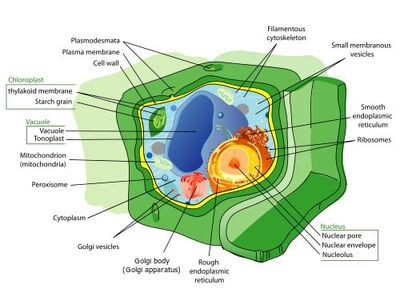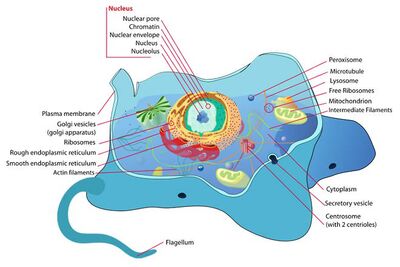
Red Blood cells present in human body contain haemoglobin which captures oxygen for respiration
Cells make up all living organisms. Without cells living organisms wouldn't be able to function properly. Many cells are microscopic, meaning they can't be seen by the naked eye. Although, a female egg cell is about the size of the dot on this i. Even though it doesn't look big, it is still big for a cell. There are many different kinds of cells: Eukaryotic Cells, Prokaryotic Cells, Plant Cells and Animal Cells. Cells make up tissue, which makes up organs and organisms. All cells have organelles in the cytoplasm to help the cell function.
Modern Cell Theory
The modern cell theory states the following:
- The cell is the smallest living unit in all organisms (basic unit of life)
- All living things are made of cells (unicellular or multicellular).
- All cells come from other pre-existing cells.
Types of Cells
Eukaryotic
A eukaryotic cell possesses a nucleus. A Eukaryotic Cell has multiple names: Eukarya & Eukaryota. Most cells have a nucleus, which contains hereditary material(s) and acts as the 'brain' of the cell. Domain Eukarya's kingdoms, Animals, Plants, Fungi, and Protists, have eukaryotic cells.
Prokaryotic
Most cells have a nucleus, but although we might not think it, there are some cells out there without a nucleus. A prokaryotic cell is the opposite of a Eukaryotic cell; Prokaryotic cells don't have a nucleus. A prokaryotic cell can be found in the bloodstream of a human or mammal. Domains Archaea and Bacteria tend to have prokaryotic cells. Because prokaryotic cells do not have nucleuses, their genetic information floats in the cytoplasm. Prokaryotic cells also lack membrane-bound organelles.
Organelles
Cell Wall (Plant Cell Only)
The Cell Wall is a rigid structure composed of cellulose that is only found in the cells of a plant. It is located just outside the cell membrane, giving protection against mechanical and osmotic stress, and providing tensile strength.
Plant Cell

Plant Cells are cells in plants that are specifically build to photosynthesize. Photosynthesis is the procedure of a plant turning sunlight into H20 and sugar/energy to keep the plant alive. Plants give out oxygen for humans to breathe. Without plants such as trees and bushes (and any plant in general) we would run low on oxygen and eventually run out. Plant Cells have Cell Walls to protect its Cell Membrane and other internal organelles.
Animal Cell

An Animal Cell (or Mammal Cell) are cells which are found in mammals. The Animal Cell doesn't contain a cell wall, whereas a Plant Cell does. Instead, the Animal Cell relies on its Cell Membrane to hold the cell together. The cell membrane regulates (monitors) what goes in and out of the cell between itself and its environment.
